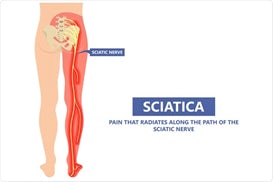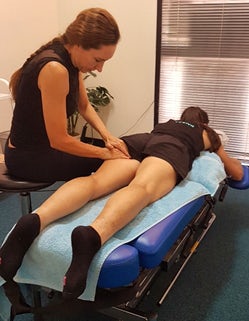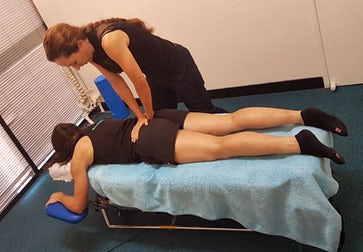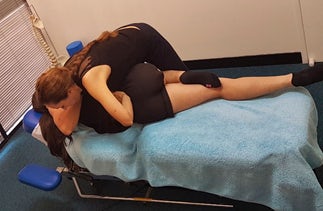
Sciatica – pain traveling down the back of your leg from your back
 Sciatica is a pain that starts in the lower back. It travels through the hips and buttocks and down the legs. It occurs when nerve roots that make up the sciatic nerve become pinched or compressed. Sciatica usually affects only one side of the body and one leg.
Sciatica is a pain that starts in the lower back. It travels through the hips and buttocks and down the legs. It occurs when nerve roots that make up the sciatic nerve become pinched or compressed. Sciatica usually affects only one side of the body and one leg.
Sciatica can be acute (short lived) or chronic- ongoing. An acute episode of sciatica may last between one and two weeks and usually resolves itself in a few weeks. It’s fairly common to experience some numbness for a while after the pain has subsided. You may also have sciatic episodes a handful of times a year (this is not normal).
Acute sciatica may eventually turn into chronic sciatica. This means the pain exists pretty regularly. Chronic sciatica may be life-long condition. Studies show sciatica can respond well to chiropractic treatment.
Symptoms of Sciatica
 Sciatica is a very distinct type of symptom. If you’re experiencing pain that flows from your lower back through your buttock area and into your lower limbs, it’s typically sciatica.
Sciatica is a very distinct type of symptom. If you’re experiencing pain that flows from your lower back through your buttock area and into your lower limbs, it’s typically sciatica.
Sciatica is the result of damage or injury to your sciatic nerve, so other symptoms of nerve damage are usually present with the pain.
Other symptoms of sciatica may include the following:
You may have pain that gets worse with movement.
You may have numbness or weakness in your legs or feet, which is usually felt along your sciatic nerve pathway. In severe cases, you may experience a loss of feeling or movement.
You may feel the sensation of pins and needles, which involves a painful tingling in your toes or feet.
You may experience incontinence, which is the inability to control your bladder or bowels. This is a rare symptom of cauda equina syndrome (CES), which is described below, and it calls for immediate emergency attention.
Causes of Sciatica
Sciatica can be caused by several conditions that involve your spine and can affect the nerves running along your back. It can also be caused by an injury, for example from falling, or spinal degeneration from old injuries, disc bulge, leg length discrepancy, scoliosis, congenital abnormalities, or poor posture.
Common conditions that can cause sciatica are described below.
Herniated discs
Your vertebrae, or spinal bones, are separated by pieces of cartilage. Cartilage is filled with a thick, clear material to ensure flexibility and cushioning while you move around. Herniated disks occur when the first layer of the cartilage rips.
The substance inside can compress your sciatic nerve, resulting in lower limb pain and numbness. It’s estimated that 1 to 5 percent from Trusted Source of all people will have back pain caused by a slipped disk at some point in their lives.
Spinal stenosis
Spinal stenosis is also called lumbar spinal stenosis. It’s characterized by the abnormal narrowing of your lower spinal canal. This narrowing can put pressure on your spinal cord and your sciatic nerve roots.
Spondylolisthesis
Spondylolisthesis is one of the associated conditions of degenerative disk disorder. When one spinal bone, or vertebra, extends forward over another, the extended spinal bone can pinch nerves that make up your sciatic nerve.
Piriformis syndrome
Piriformis syndrome is a rare neuromuscular disorder in which your piriformis muscle involuntarily contracts or tightens, causing sciatica. Your piriformis muscle is the muscle that connects the lower portion of your spine to your thighbones. When it tightens, it can put pressure on your sciatic nerve, leading to sciatica. Piriformis syndrome can worsen if you sit for long periods, fall, or experience a sudden jar.

Risk factors of Sciatica
Certain behaviours or factors can raise your risk of developing sciatica. The most common factors for developing sciatica include the following:
As your body ages, it becomes more likely that parts will wear out or break down.
Certain careers place a lot of strain on your back, especially those that involve lifting heavy objects, sitting for extended periods, or twisting movements.
Having diabetes can increase your risk of nerve damage. Smoking can cause the outer layer of your spinal disks to break down.
Treatment Options for Sciatica
If your pain doesn't improve with self-care measures, your chiropractor might suggest some of the following treatments modalities.
Chiropractic spinal activator mobilisations and adjustments for fixated joints to restore range of motion, joint function and provide pain relief. Dry needling/acupuncture therapy and electrotherapy to the lower back to reduce inflammation and promote healing. Flexion distraction on the lower back to stretch tight muscles and relieve pressure off spinal discs and sciatic nerve roots. Some soft tissue work to promote blood flow and release active trigger points. Category 3 SOT blocking may also be used to reduce the disc protrusion (to create negative pressure in the discs to reduce pressure on nerves). Lower back stretches given and to limit sitting or lifting. Pilates suggested and management sheet of sciatica given.

Sciatica Prevention
The following steps can help you prevent sciatica or keep it from occurring again: Exercise often. Strengthening your back muscles and your stomach or core muscles is the key to maintaining a healthy back.
Mind your posture. Make sure your chairs offer proper support for your back, place your feet on the floor while sitting, and use your armrests.
Mind how you move. Lift heavy objects in the proper way, by bending at your knees and keeping your back straight.
Schedule an Appointment


